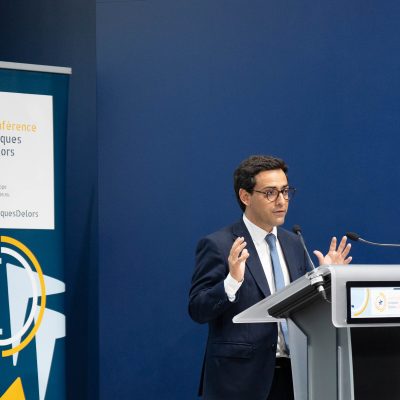The MFF package: A ambitious proposal from a fragile Commission

Yesterday the European Commission unveiled a bold and far-reaching proposal for the European Union’s next long-term budget. The new blueprint for 2028–2034 attempts to modernise the EU budget architecture and reorient spending priorities to reflect today’s geopolitical and economic realities. It is, by all accounts, a radical proposal which includes various positive elements.
A significant increase in financial ambition
To begin with, the financial ambition is notable. With a proposed envelope of €1.98 trillion in current prices (€1.76 in 2025 prices), the Commission is calling for a real-term increase of over 40% compared to the current MFF. This is significant, even excluding the amounts reserved to repaid the NGEU costs (€168 in current prices). To finance this increase, the Commission proposes a mix of new Own Resources (such as a new tax on tobacco and a lump-sum contribution on corporates of more than €100m of turnover) and adjustments to existing own resources — such as an increase in the call rate of the tax on non-recycled plastic or a reduction in collection costs applied to customs duties. If fully realised, these reforms could generate around €400 billion in additional revenue. However, it remains far from certain that this will be enough to convince Member States to agree on a bigger budget, all the more if we take into account that part of the ‘additional’ money is not really additional. Already, countries like Germany have voiced strong opposition to any major increase in the size of the EU budget.
A shift in spending priorities
The Commission also proposes a rebalancing of spending priorities. The merging of programmes and headings makes direct comparisons with the current MFF more complex (a more detailed analysis will follow shortly from my colleagues at the Jacques Delors Centre and myself). Still, one overarching trend is evident: the share of traditional policies — the Common Agricultural Policy (CAP) and Cohesion Policy, which currently represent two-thirds of the budget — is set to decline in real terms. Instead, more funding is earmarked for new or reinforced priorities. Security and defence see a five-fold increase, while key EU-added value programmes are significantly reinforced such as Horizon Europe (almost doubling the budget), the Connecting Europe Facility (CEF) for energy and transport, Erasmus+ and the new AgoraEU programme which will provide support for democracy. Spending for external action is also reinforced — a necessary adjustment in today’s turbulent global environment.
This rebalancing is both timely and necessary. Yet to be politically viable, it should be accompanied by reforms that enhance the effectiveness of CAP and cohesion policy, enabling them to deliver better with fewer resources. Whereas there seems to be genuine attempt to improve the functioning of CAP – for instance, proposing changes to better target income support to the farmers most in need- the situation is much more confusing as regards cohesion, which risks being diluted in the new ‘National and Regional Partnerships’.
More flexibility — for normal and exceptional times
Another welcome innovation is the push for greater flexibility. The proposal strengthens some special flexibility instruments– such as the Flexibility Instrument, which doubles in size- but also includes unallocated amounts or cushions in key programmes with the possibility to use them when necessary. In particular, a share of Member States’ ‘national and regional partnerships’ will remain unprogrammed and will become available both for crisis support or to respond to new policy needs at the time of the mid-term review of the plans. The Council and the Parliament will also have some capacity to reallocate funds across budgetary windows within the Competitiveness Fund during the annual budgetary procedure. Finally there is the proposal to create an exceptional and temporary crisis mechanism to provide additional loans to Member States in case of a large crisis, that can be activated jointly by the Council and Parliament.
All these flexibilities are welcome given the current climate of uncertainty. However, greater flexibility inevitably entails greater discretion for executives—both at EU and national level. To be legitimate, flexibility must be accompanied by robust accountability mechanisms and appropriate oversight.
Rule of law conditionality: sharper tools, but will they be used?
Finally, the link between the use of EU funds and respect for the rule of law is significantly strengthened. The experience with Hungary has shown how difficult it is to trigger the Rule of Law Conditionality Regulation—which requires a Council vote and proof that rule of law breaches have seriously and directly affected the use of EU funds. By contrast, it has proven much easier to suspend Cohesion Policy payments using the so-called horizontal enabling condition, which ties EU funding to compliance with the Charter of Fundamental Rights.
The Commission has drawn lessons from this and now proposes to extend this Charter-based enabling condition to all funds covered by the national and regional partnership agreements. In practical terms, this would mean that CAP payments could be suspended in case of violations of the Charter—something that was previously only possible for Cohesion and migration funds.
Moreover, the Commission suggests introducing a horizontal rule of law conditionality across all these partnerships. Unlike the current mechanism, this new tool would not require Council approval, allowing the Commission to suspend payments on its own initiative in the event of serious rule of law breaches.
Whether these proposals will be effective, however, will ultimately depend on the political will and courage of the Commission to fully enforce them.
Conclusion: Boldness from a weakened institution
This is an ambitious proposal, and the Commission deserves credit for putting bold ideas on the table. Yet this is also a fragile Commission. Internally, the preparation of this MFF exposed serious disagreements within the College of Commissioners and DGs. Externally, the Commission is facing mounting criticism from the European Parliament for its lack of transparency and limited accountability. In this context, a reform proposal that not only reshapes EU spending but also strengthens the role of the Commission itself risks facing resistance. Whether this initiative becomes a historic leap forward or another unrealised blueprint will depend not only on its content, but on the Commission’s ability to build bridges and restore trust.




